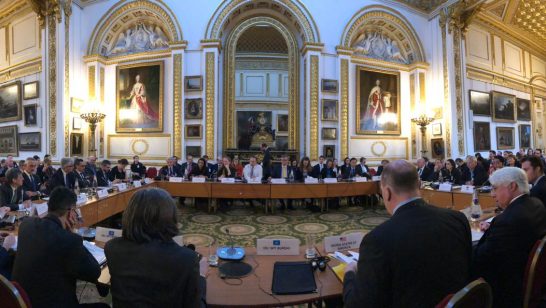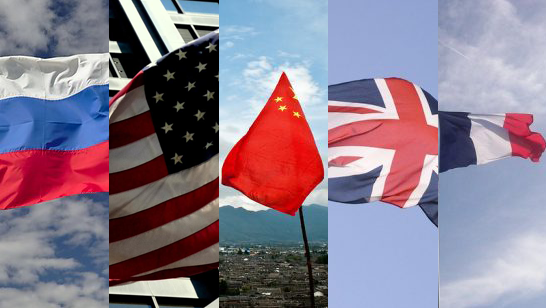
The five nuclear-weapon states – China, France, Russia, the United Kingdom, and the United States (collectively known as the P5) – as recognised by the Treaty on the Non-Proliferation of Nuclear Weapons (NPT), convened their tenth formal conference in London between 12–14 February. The conference addressed ways in which the P5 can better fulfil their responsibilities under the NPT’s three pillars: non-proliferation, disarmament and peaceful uses of nuclear technology.
The London discussions of senior P5 representatives and unprecedented P5 engagement with civil society, coordinated by King’s College London (KCL) and the European Leadership Network (ELN), were revealing. Continued work through the P5 Process on improved cooperation and transparency is encouraging, yet there remains scope for more to be done to improve transparency and advance the goals of the NPT. In particular, further engagement with civil society is a valuable tool for countering criticism of opacity and for identifying opportunity for progress.
KCL and ELN shadowed the P5 deliberations during the UK’s tenure as coordinator of this process. With the aim of increasing the transparency of the P5 nuclear dialogue through expert workshops, the joint KCL-ELN project identified key opportunities and challenges for the P5 process in the lead-up to the 2020 NPT Review Conference (RevCon).
For the February P5 conference, ELN and KCL convened 76 experts (over half of whom were women) to discuss the project’s recommendations with senior officials in a two-day ‘side event’. The group comprised members from each of the P5 states, as well as 16 non-nuclear weapons states. This represented an unprecedented level of civil society engagement with the P5 Process, and the various breakout group, small roundtable and plenary settings provided valuable opportunities for the exchange of ideas, responses to criticism, and discussion of avenues of progress for the P5.
The conference provided the P5 with an opportunity to demonstrate their commitment to increased transparency, particularly through the main on-the-record plenary session. The conference revealed agreement amongst the P5 on some topics, such as the Treaty on the Prohibition of Nuclear Weapons (TPNW), strategic risk reduction efforts and the Glossary of Key Nuclear Terms, but mistrust and disagreement over nuclear modernisation programmes and approaches to formal arms control agreements.
The P5 reiterated their joint opposition to the TPNW, which in their view represents a ‘dangerous and unrealistic shortcut to nuclear disarmament without addressing the security challenges associated with the existence of nuclear weapons’. The TPNW also undermines the NPT, according to the P5, because Article 18 suggests that the TPNW supersedes in case of a conflict with other treaties.
With 35 ratifications, there is a chance that the TPNW will reach the required 50 ratifications for entry-into-force before the next RevCon. This possibility has grown with the postponement of the 2020 RevCon due to the outbreak of COVID-19, buying TPNW supporters more time to persuade potential signatories of the Treaty’s value, whilst TPNW signatory states have more time to complete the ratification process. KCL-ELN deliberations found that there is a risk that the P5’s continued vocal opposition to the TPNW could alienate its’ non-nuclear-weapon state proponents—a development that the P5 should seek to avoid by either ignoring the TPNW altogether or by adopting less confrontational language.
An area of agreement between the P5 is the Glossary of Key Nuclear Terms. Formally agreed at the 2009 London P5 conference to foster a common understanding of nuclear terminology, the P5 presented a first edition of the Glossary at the 2015 RevCon, which struck some observers as a distraction from disarmament, offering few original insights as the P5 could not agree on particular terms, and borrowing definitions from existing bilateral and IAEA glossaries. At their February conference, the P5 announced that they had resolved disagreements on additional definitions, paving the way for a second edition to be presented at the next RevCon. The Glossary has received criticism, but the P5 claim a common understanding of key nuclear terms can provide the necessary framework for concrete disarmament measures.
Another more promising area of agreement addressed at the civil society conference was strategic risk reduction. Led by France, the P5 reiterated their willingness to engage in risk reduction activities, announcing efforts to build ‘strategic trust amongst the P5’ and noting that strategic risk reduction is not an alternative to disarmament.
Though a promising step towards addressing non-nuclear-weapon states’ concerns about growing nuclear risk, the P5 stopped short of offering details to the civil society experts about their strategic risk reduction measures. A key recommendation of the KCL-ELN project for increasing P5 transparency and efficacy in this area is to establish a working group to inventory and mitigate the ‘actions, deployments, activities or behaviours [that] could lead to misunderstandings or miscalculations [and] trigger or exacerbate a crisis’.
The P5 also made progress on discussions about their nuclear doctrines. Increasing transparency around doctrines is one way for the P5 to reduce risks associated with misperceptions of each other’s intentions or likely strategic calculus. The P5 assessed such discussions to be so valuable that they agreed to make the doctrines discussion a permanent feature of the P5 Process agenda, and plan to brief non-nuclear-weapon states on their doctrines deliberations at a RevCon side-event.
Though a valuable development, the P5 could better counter the criticism of doctrinal opacity by providing specific examples of how the doctrines discussions have resolved misunderstandings, which they failed to do at the London conference. The P5 could also facilitate constructive engagement with the non-nuclear-weapon states by ‘produc[ing] a joint P5 doctrines paper with the collated responses’ to questions allowing the wider NPT membership to better understand their individual doctrines.
Areas of disagreement and a lack of trust amongst the P5 were also evident throughout the conference. P5 members cast doubt on each other’s intentions, expressing concerns about nuclear modernisation programmes and alleged non-compliance or deliberate undermining of arms control agreements. China rejected calls for trilateral arms control talks with Russia and the US for as long as the nuclear arsenals of all three remained unequal.
The London civil society conference provided the P5 with an opportunity to demonstrate their commitment to transparency and to discuss key issues with civil society experts. While progress within the P5 Process is encouraging; there remains scope for improvement. The joint KCL-ELN project has identified opportunities and challenges for the P5 and has resulted in practical recommendations to better fulfil their NPT obligations as the next RevCon approaches. Postponement of this key event will provide additional time for the P5 to build towards greater transparency and cooperation. To ensure success in this NPT review cycle and beyond, the P5 must more seriously consider the value of civil society engagement, and leverage the recommendations of NGO projects to improve the efficacy and transparency of their own work and to counter criticism of opacity.
The opinions articulated above represent the views of the author(s) and do not necessarily reflect the position of the European Leadership Network or any of its members. The ELN’s aim is to encourage debates that will help develop Europe’s capacity to address the pressing foreign, defence, and security policy challenges of our time.




